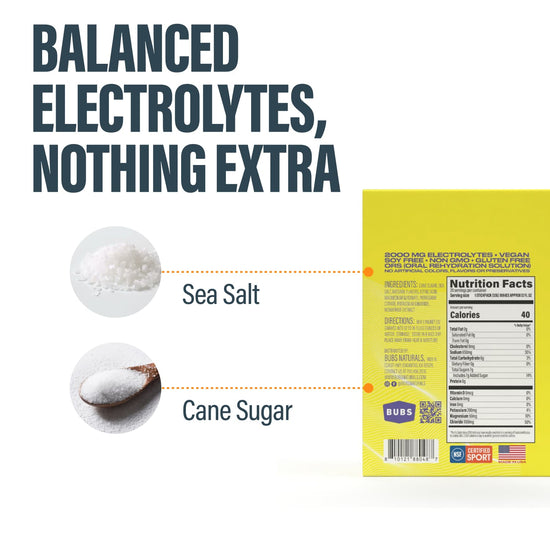Table of Contents
- Introduction
- What Are Electrolytes and Why Do They Matter?
- Signs You Need to Replenish Electrolytes
- How Much Electrolytes Should You Consume After a Workout?
- Effective Ways to Replenish Electrolytes
- Conclusion
- FAQ
Have you ever felt that post-workout fatigue that lingers longer than it should? It's not just your muscles crying out for relief; it could be a sign that your body is in dire need of electrolytes. Electrolytes are the unsung heroes of hydration and recovery, playing crucial roles in muscle function, hydration, and overall health. In this blog post, we will dive deep into the importance of replenishing electrolytes after exercise, how much you actually need, and how BUBS Naturals can help you in your journey toward optimal wellness.
Introduction
Electrolyte balance is something many of us overlook, especially after an intense workout. Did you know that during vigorous exercise, our bodies can lose significant amounts of electrolytes through sweat? Research shows that athletes can lose anywhere from 200 milligrams to over 2,000 milligrams of sodium, depending on various factors such as exercise intensity, duration, and individual sweat rates. This loss can lead to dehydration, cramping, and decreased performance if not properly replenished.
As a wellness brand inspired by the legacy of Glen “BUB” Doherty, we at BUBS Naturals prioritize the importance of adventure, wellness, and giving back. Our commitment to providing clean, functional supplements reflects our belief in living an active and purposeful life. In this article, we’ll cover:
- What electrolytes are and why they matter
- The signs that indicate your body needs electrolytes
- Recommended amounts of electrolytes to consume after a workout
- How to replenish electrolytes effectively, including our recommended products
By the end, you’ll have a comprehensive understanding of how much electrolytes you should consume after a workout and how to incorporate them into your post-exercise routine.
What Are Electrolytes and Why Do They Matter?
Electrolytes are minerals that carry an electric charge, and they play a significant role in various bodily functions, including:
- Fluid balance: Electrolytes help regulate the balance of fluids in the body.
- Muscle function: They are crucial for muscle contraction and relaxation.
- Nerve function: Electrolytes facilitate nerve impulses that are vital for movement and coordination.
- Acid-base balance: They assist in maintaining the body's pH levels.
The primary electrolytes include sodium, potassium, calcium, magnesium, and chloride. Sodium is particularly important during and after exercise, as it is the most abundant electrolyte lost through sweat. Maintaining the right balance of electrolytes is essential for optimal performance and recovery.
Signs You Need to Replenish Electrolytes
Recognizing the signs that your body needs electrolytes can help you take action before dehydration sets in. Common indicators include:
- Fatigue: Feeling unusually tired after a workout can signal an electrolyte deficiency.
- Muscle cramps: Sudden cramps may indicate a lack of sodium and potassium.
- Headaches: Dehydration from electrolyte loss can lead to headaches.
- Dizziness or lightheadedness: This can occur when blood pressure drops due to low sodium levels.
- Decreased performance: A noticeable decline in your workout intensity or duration may be a sign that your body is not adequately replenished.
If you experience any of these symptoms, it’s crucial to address your electrolyte levels promptly.
How Much Electrolytes Should You Consume After a Workout?
The amount of electrolytes you need post-workout can vary significantly based on several factors, including:
- Duration and intensity of exercise: Longer and more intense workouts lead to greater electrolyte loss.
- Individual sweat rate: Some individuals are "salty sweaters," losing more sodium than others.
- Environmental conditions: Hot and humid conditions can increase sweat production.
As a general guideline, most experts recommend:
- Sodium: Aim for about 200 to 500 milligrams of sodium after a workout, particularly if you've exercised for more than an hour.
- Potassium: Consuming around 300 to 500 milligrams of potassium is beneficial, especially if your workout was prolonged.
- Magnesium and Calcium: Though these are lost in smaller amounts, including some sources in your post-workout nutrition can help maintain balance.
To put this into perspective, if you've engaged in a high-intensity workout lasting over an hour, replenishing your sodium intake with a sports drink or electrolyte supplement is advisable.
Effective Ways to Replenish Electrolytes
Replenishing electrolytes can be done through various methods, including:
1. Hydration with Electrolyte Drinks
Drinking electrolyte-infused beverages is one of the quickest ways to restore balance. Our Hydration collection at BUBS Naturals includes the "Hydrate or Die" electrolyte powder, which features a coconut water base and full-spectrum minerals to support hydration without added sugars. Explore our collection here.
2. Food Sources
Incorporating foods rich in electrolytes is another effective strategy. Here are some options:
- Sodium: Pickles, olives, and salted nuts
- Potassium: Bananas, oranges, and sweet potatoes
- Magnesium: Leafy greens, nuts, and legumes
- Calcium: Yogurt, cheese, and fortified non-dairy alternatives
3. BUBS Naturals Products
To make replenishing electrolytes simpler and more effective, we recommend our Hydration collection. Our products are designed to mix effortlessly into your daily routine, ensuring you stay hydrated and energized. Check out our Hydration collection to feel the BUBS difference.
Conclusion
Understanding how much electrolytes you need after a workout is essential for maintaining optimal performance and recovery. By recognizing the signs of electrolyte depletion and knowing how to replenish them effectively, you can support your active lifestyle and overall wellness.
At BUBS Naturals, we are committed to providing clean, high-quality supplements to support your wellness journey and honor the legacy of Glen "BUB" Doherty. Remember, hydration is not just about water; it’s about giving your body the tools it needs to thrive.
Take the time to listen to your body and ensure you are replenishing electrolytes appropriately after your workouts. Your active lifestyle deserves it!
FAQ
Q1: Can I drink plain water after a workout? While plain water is crucial for hydration, it may not be sufficient after intense workouts. For optimal recovery, it's best to combine water with electrolyte-rich beverages.
Q2: How can I tell if I’m a salty sweater? If you notice white salt stains on your skin or workout gear after sweating, you may be a salty sweater. You might also experience more cramping or fatigue post-exercise.
Q3: Is it possible to overhydrate with electrolytes? Yes, excessive electrolyte intake can lead to imbalances. It’s essential to consume them in moderation and based on your specific needs.
Q4: Are there any side effects of electrolyte supplements? Most people tolerate electrolyte supplements well; however, individuals with health conditions like high blood pressure should consult a doctor before taking them.
Q5: How often should I replenish electrolytes during prolonged exercise? For workouts exceeding 60 minutes, consider replenishing electrolytes every 30 to 60 minutes to maintain optimal levels.
By prioritizing your hydration with BUBS Naturals, we’ll work together to keep you feeling energized and ready for your next adventure!
Written by:
Bubs Naturals

Hydrate or Die
When you’re sweating hard—whether it’s from a tough workout, a long day in the sun, or just life—your body needs more than water to stay balanced and energized.
Hydrate or Die® delivers 2,000 mg of electrolytes in every serving to help you rehydrate faster, fight off fatigue, and keep going strong. That includes the right mix of sodium, potassium, and magnesium to support muscle function, prevent cramps, and maintain energy levels.
With a small dose of natural cane sugar to speed up absorption, this clean, easy-to-use powder is made for real performance—not just flavor.
Starts at $29.60
Shop

